fall inside a hole
1970 Tanker, Flatbed, and Container Cars
First written November 15, 2023Expanded October 2025
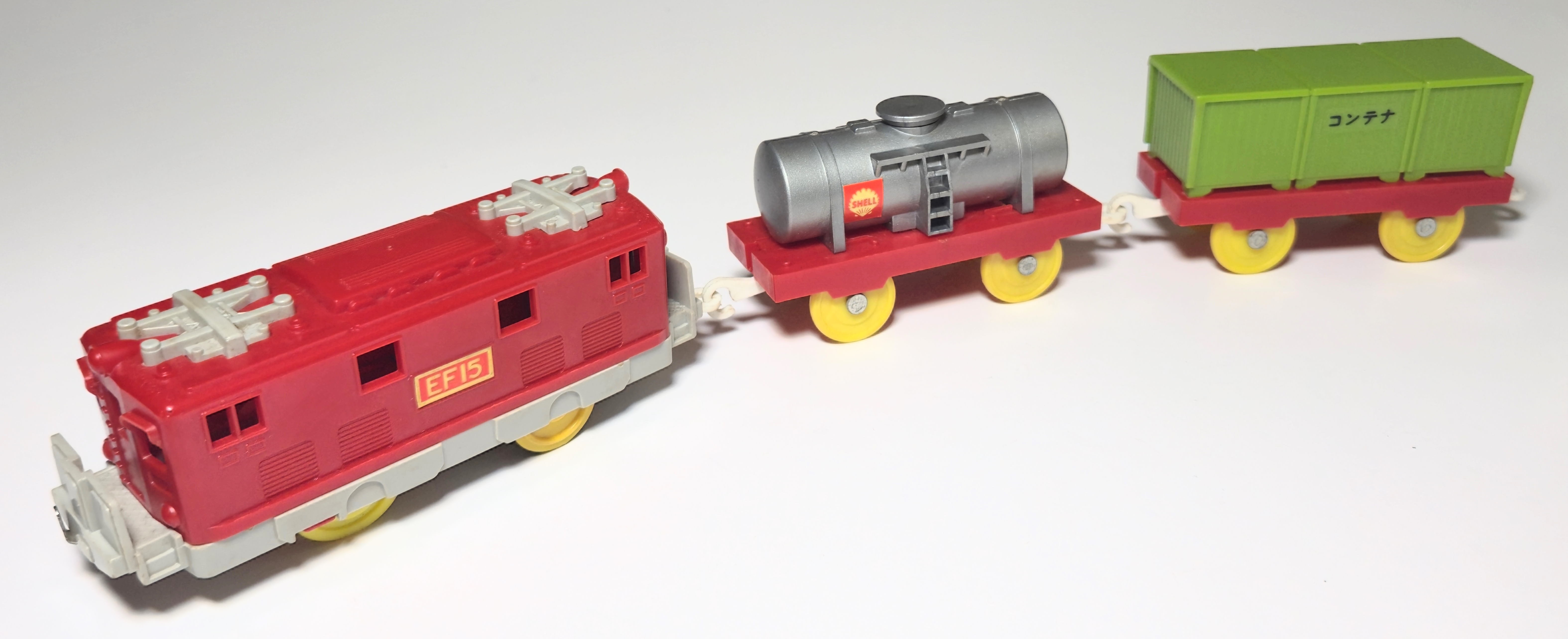
In 1970 a flatbed car carrier, well wagon, container car and a tanker car were developed that shared a common chassis. The earliest releases of these cars in sets used an earlier more fragile axle holder design and flatter early 70s couplings - the earliest types have red chassis instead of yellow, which they were changed to around 1972.
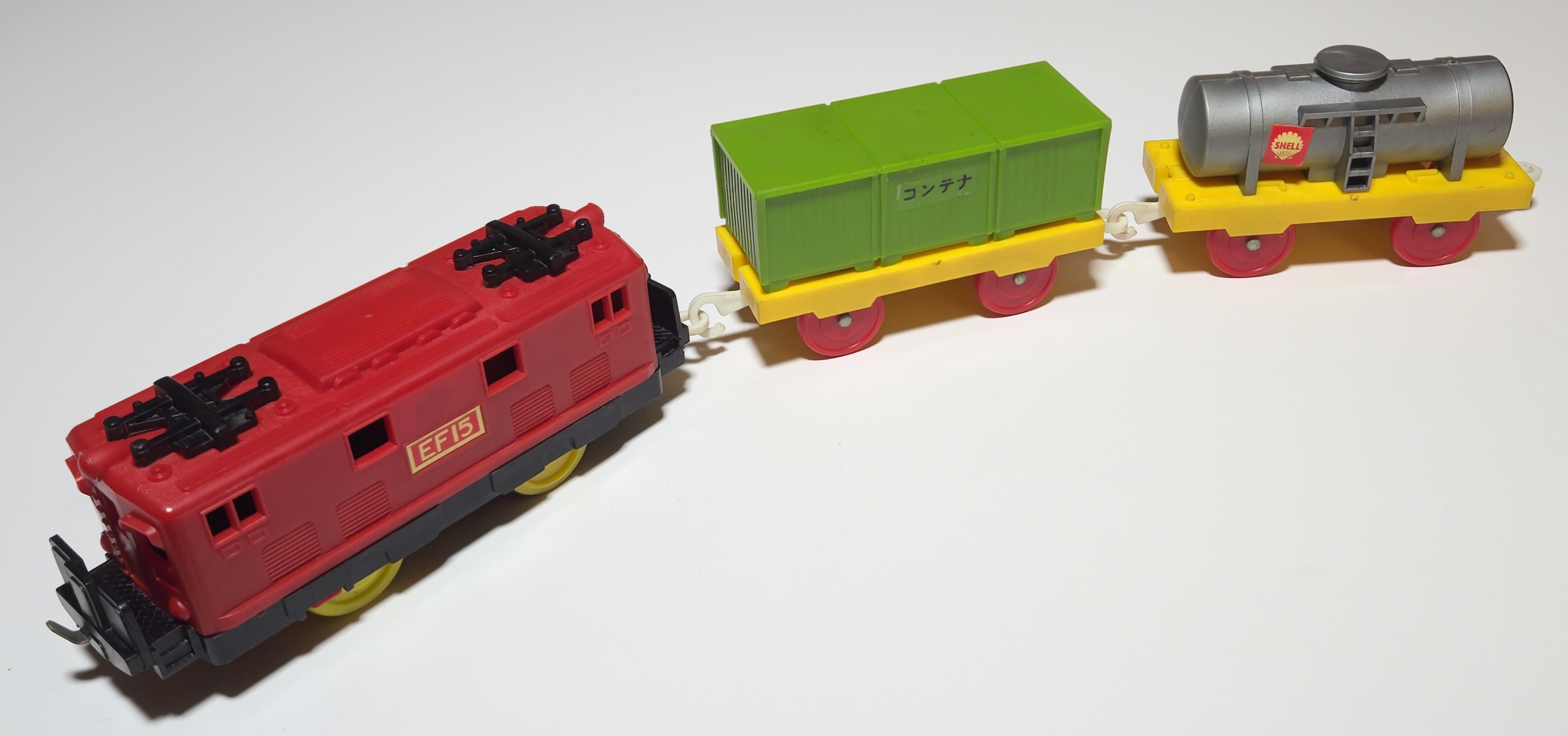
By the 1980s they were updated to have more robust chassis and in the 1990s production was moved to Thailand for the tanker and container car which survived for longer, with the well wagon and auto carrier being phased out by the later 1970s.
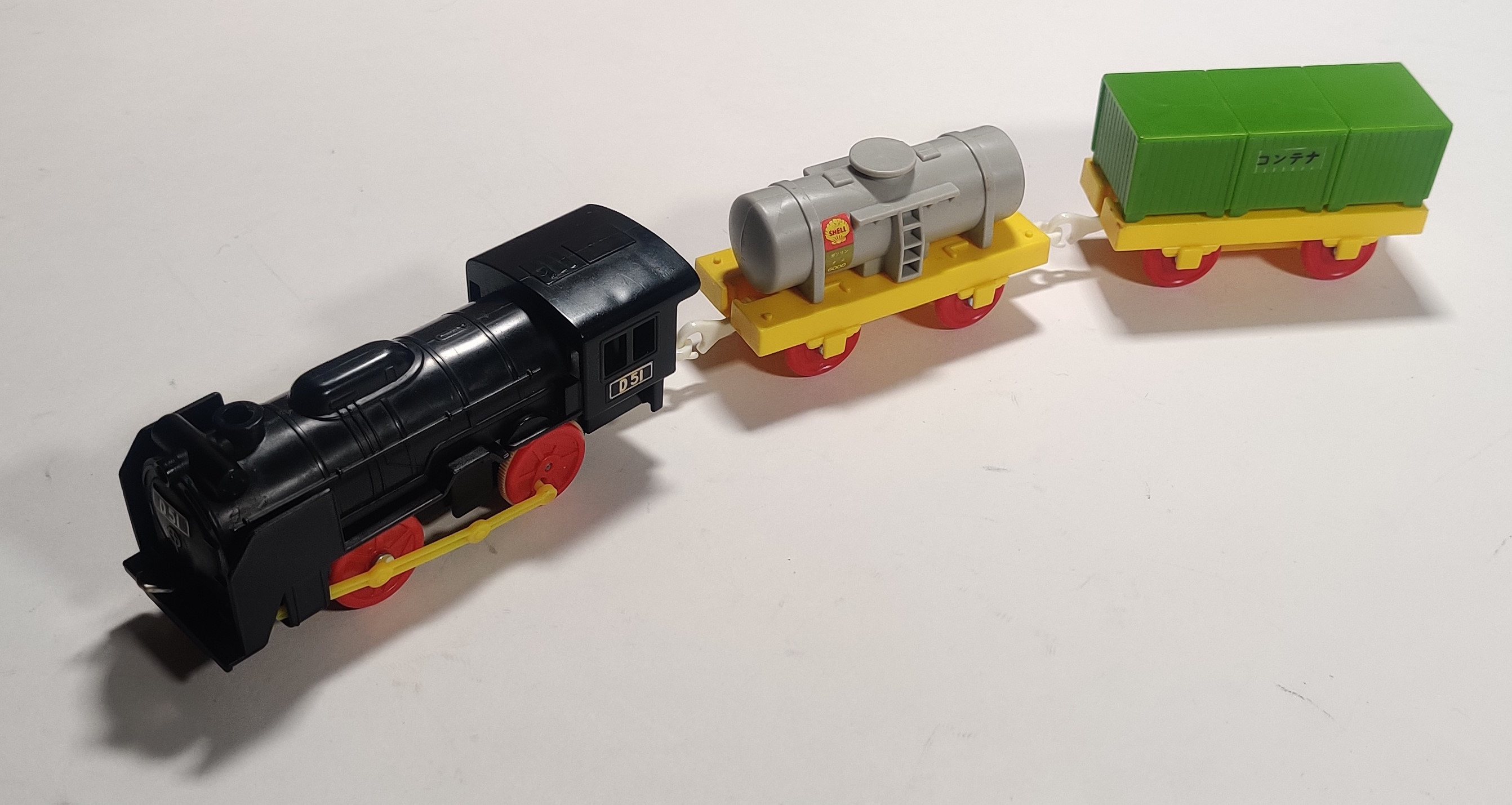
In 1976 the grey Shell tanker, green container car, and a white recolor of the container car as a refrigerator car were released individually. Between this and their inclusion in packs like the original D51 with Light the tankers and container cars are both relatively common. The tanker was also used for the original Plarail Percy, and the tooling was used into the early 2000s as an alternate tanker design to the new one developed in the late 90s for the Thomas series.
Container Car
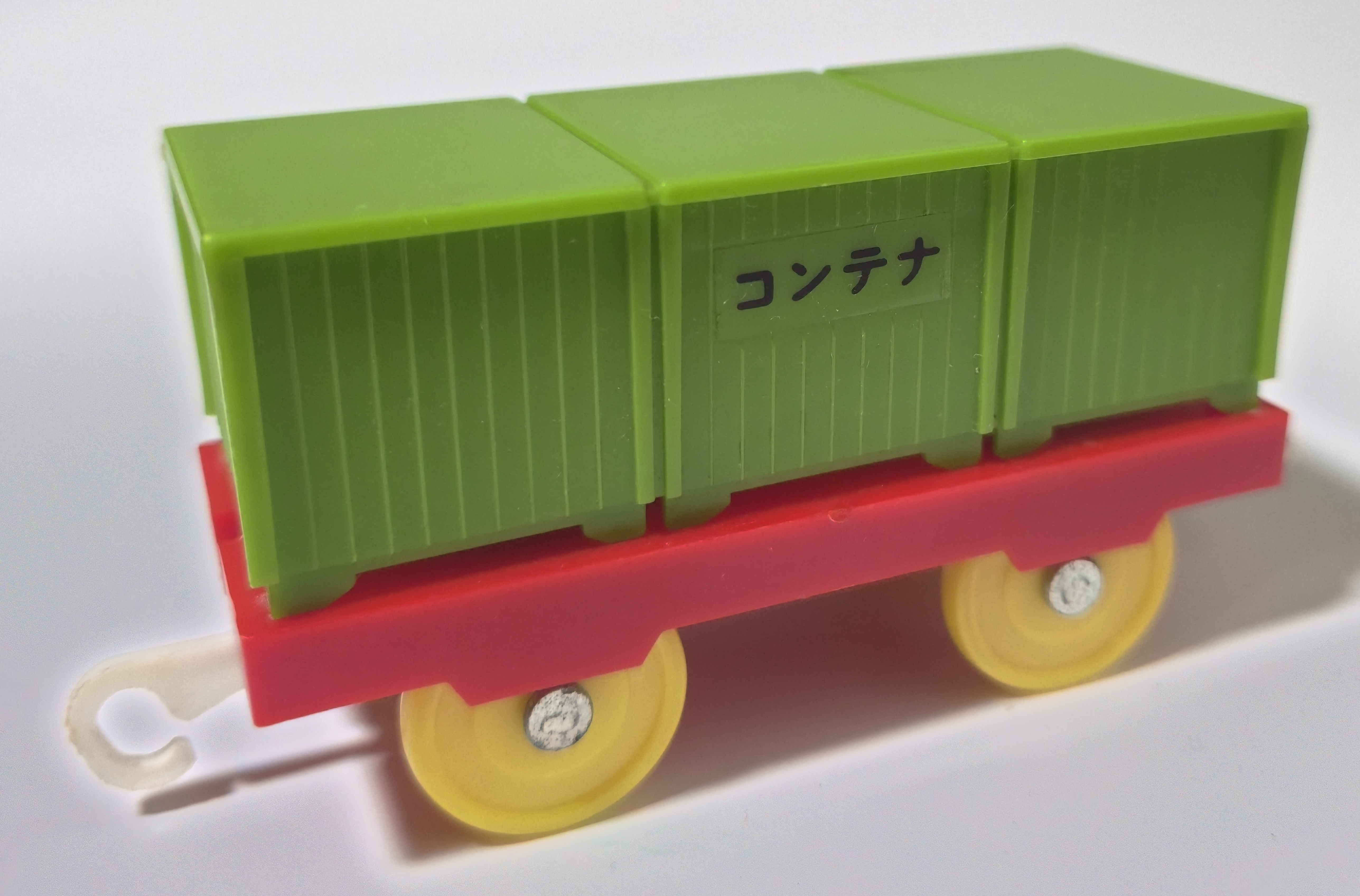
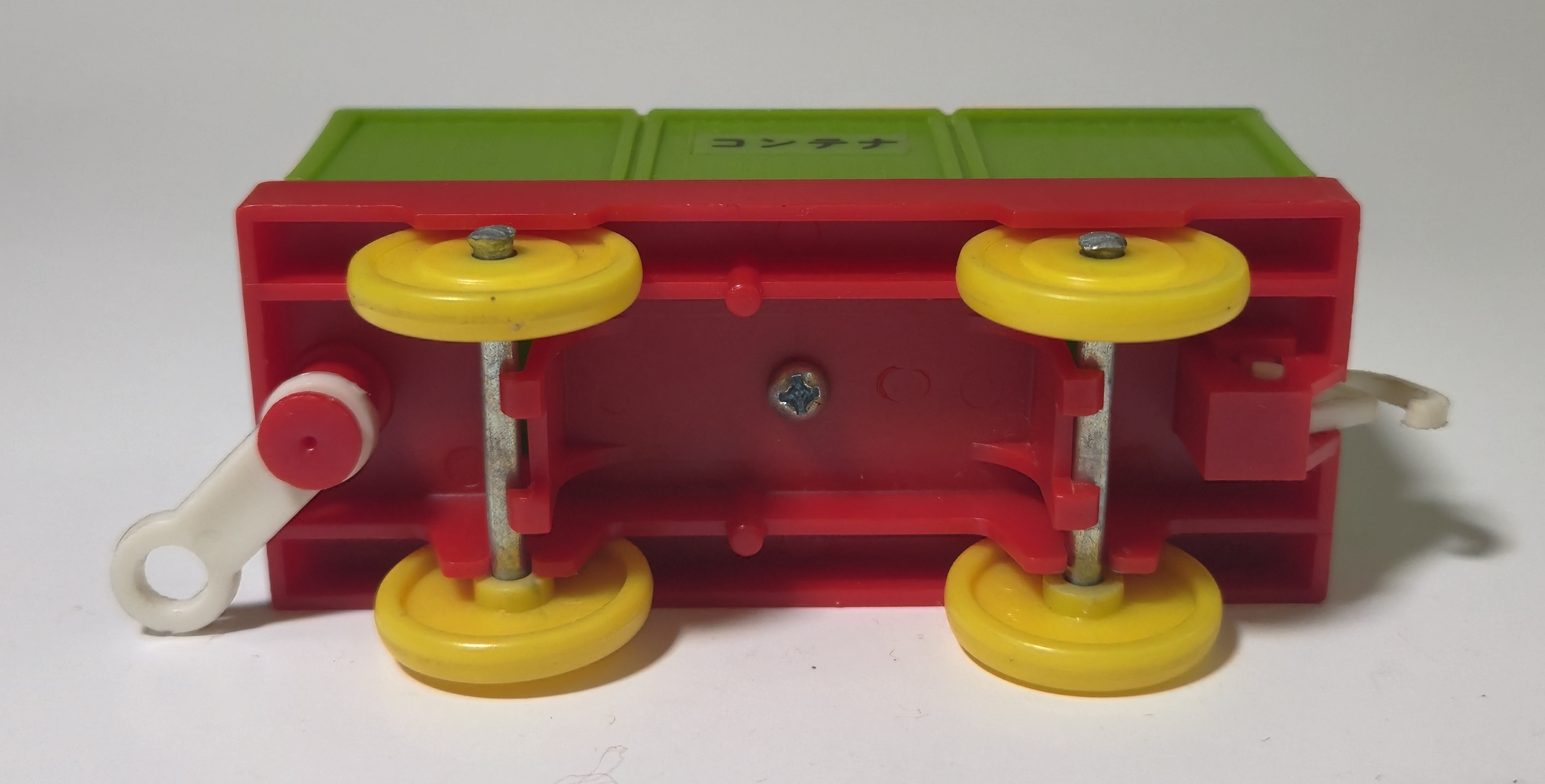
The 1970 container car depicts three shipping crates arranged in a line on the same flat classis as the other cars. Unlike the later container cars, the containers are non-removable and screwed into the chassis. The text on the side of the car reads コンテナ or "container." These early types were included with the EF-15 Electric Locomotive and have fragile axle holders and plastic plugs to hold in the rear coupling.

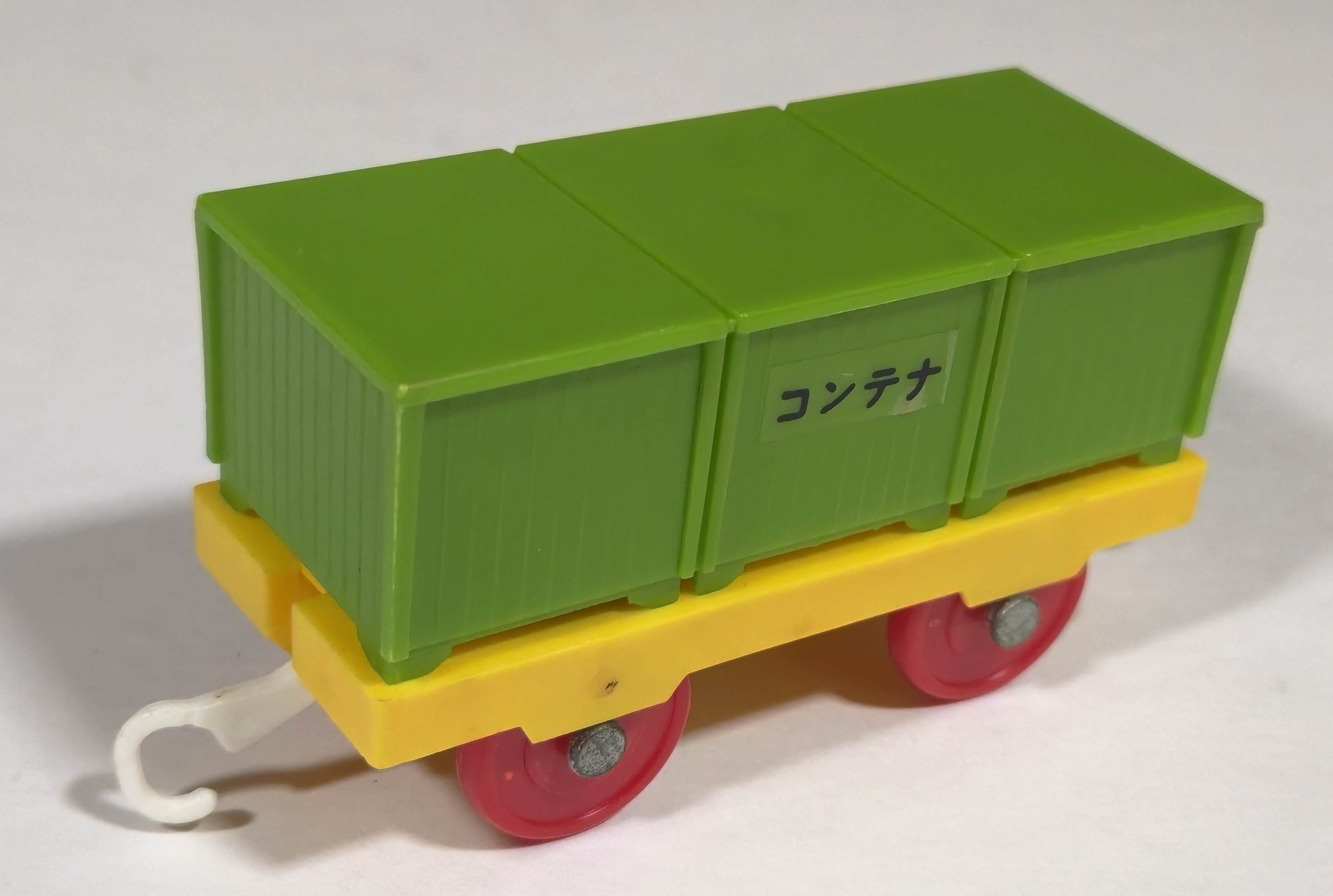
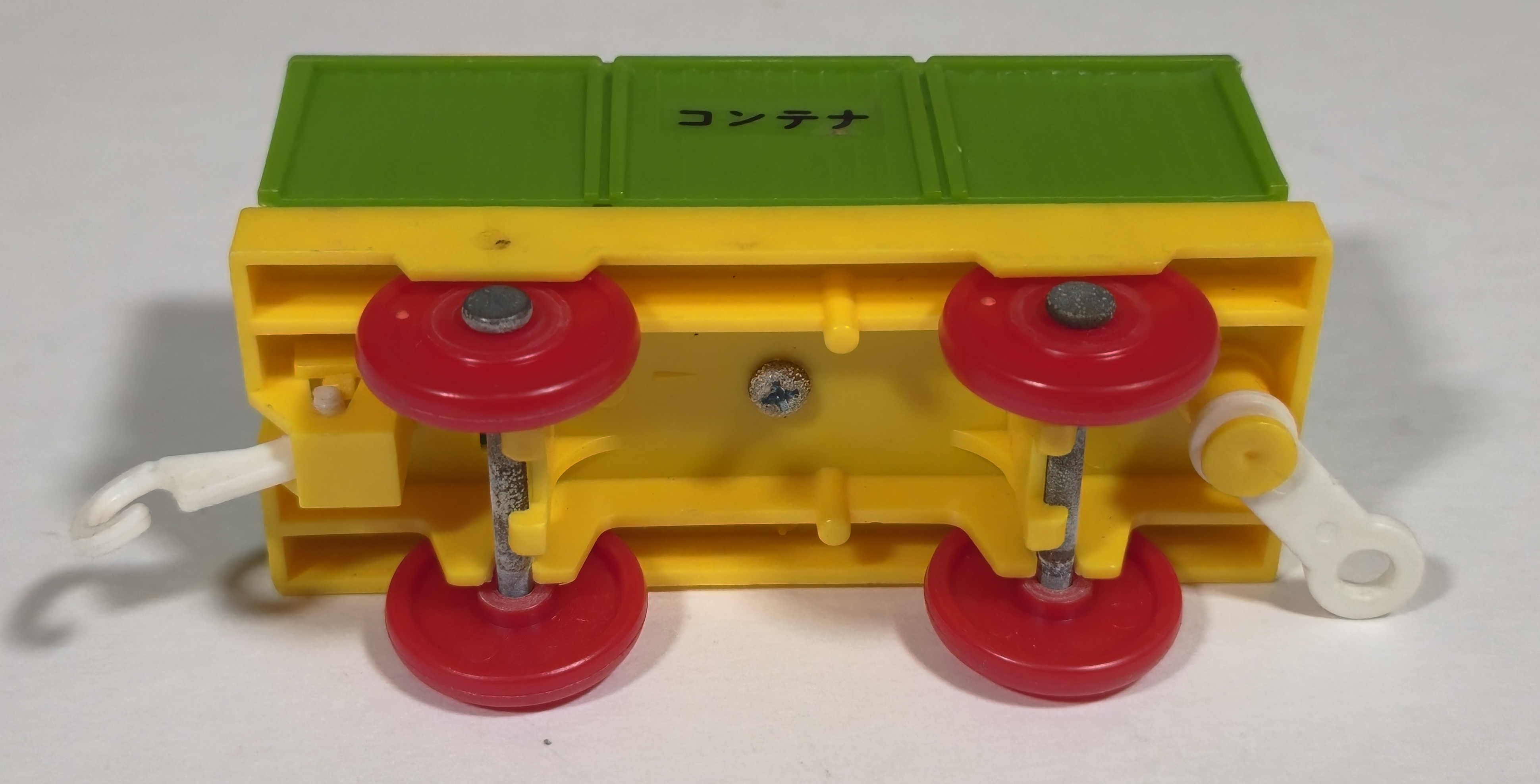
The very first releases with the EF-15 Electric Locomotive in 1970 had red chassis with yellow wheels but not long after this was swapped around.
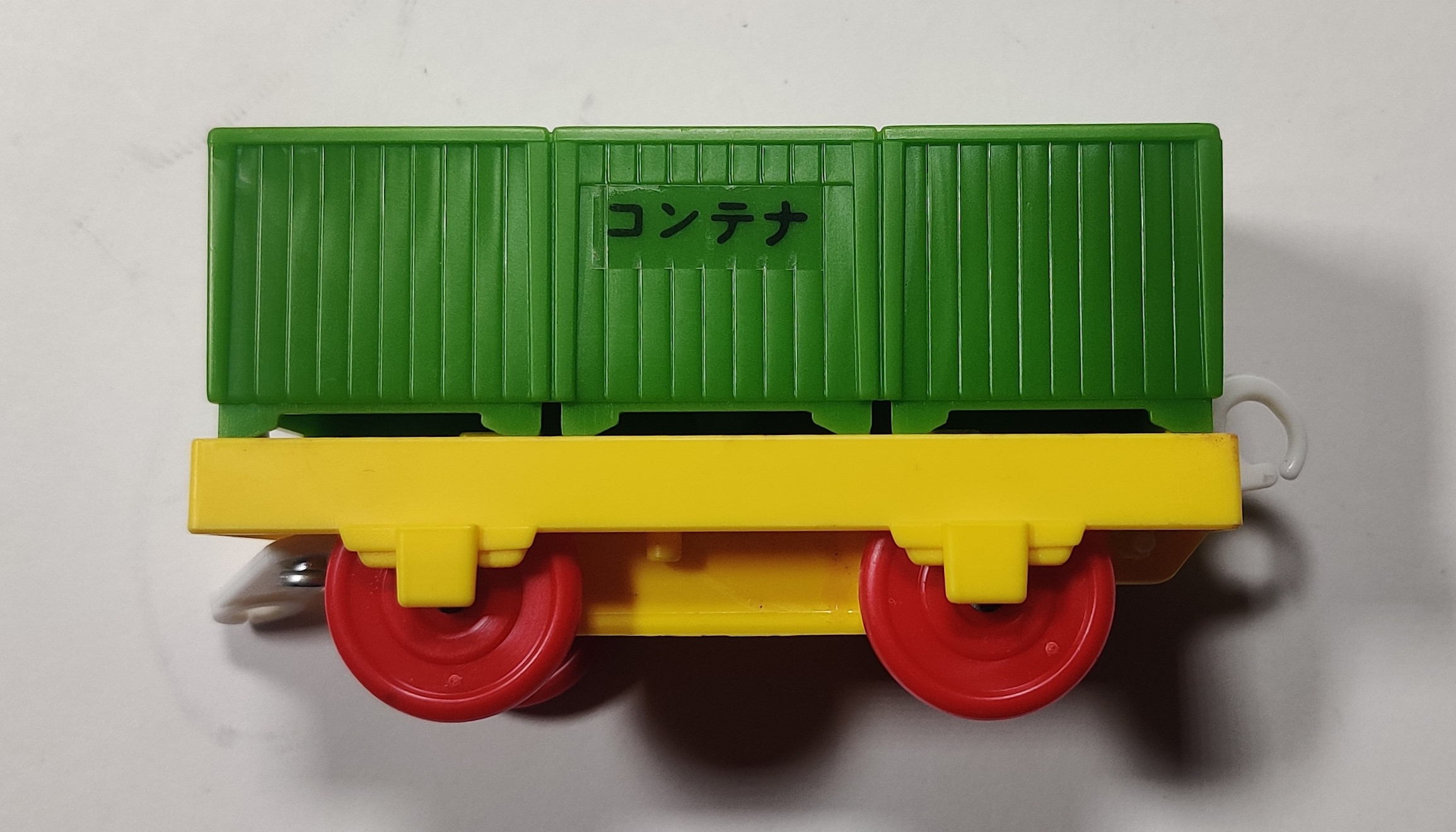
The chassis also gained axleboxes by the mid 1970s before the time of the 1976 individual release, and in the later 1970s the chassis was changed to hold the wheels with the more sturdy and secure separate carrier plate. Like the grey Shell tanker, this truck was included in a number of earlier 1970s three-pack releases and the 1980 D51 with Light. Between 1982 and 1984 the green container disappears from the individual car section of the catalogues.
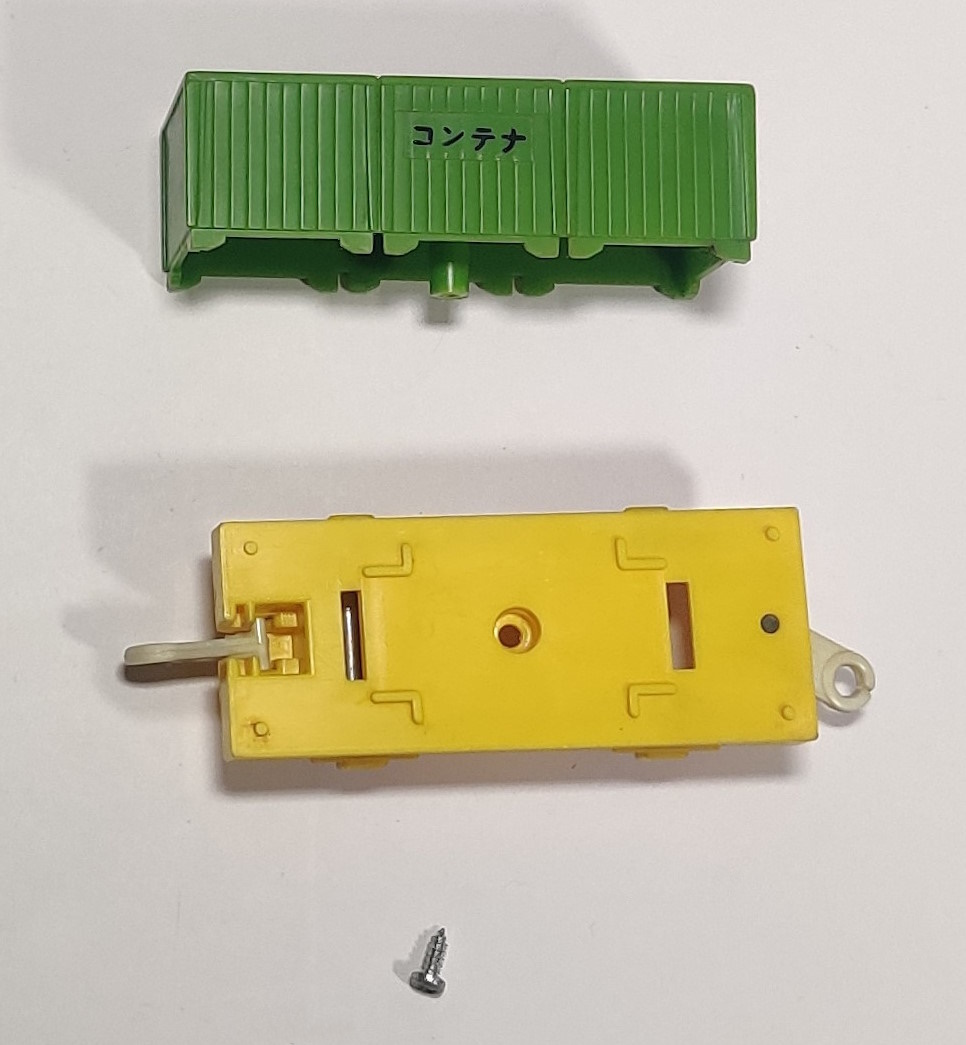
The chassis for these cars is the same basic mostly-flat bed with locating pegs and molding features to accommodate the different cars it was used in. A screw secures the container to the base. After the car flatbed was dropped from production it seems that for extra support the hole in the center of the chassis was made wider to a certain depth to allow for the container's screw stem to extend further downward into the base. The smaller screw hole can be seen in the tanker disassembly and auto carrier photos below.
Refrigerated Container Car
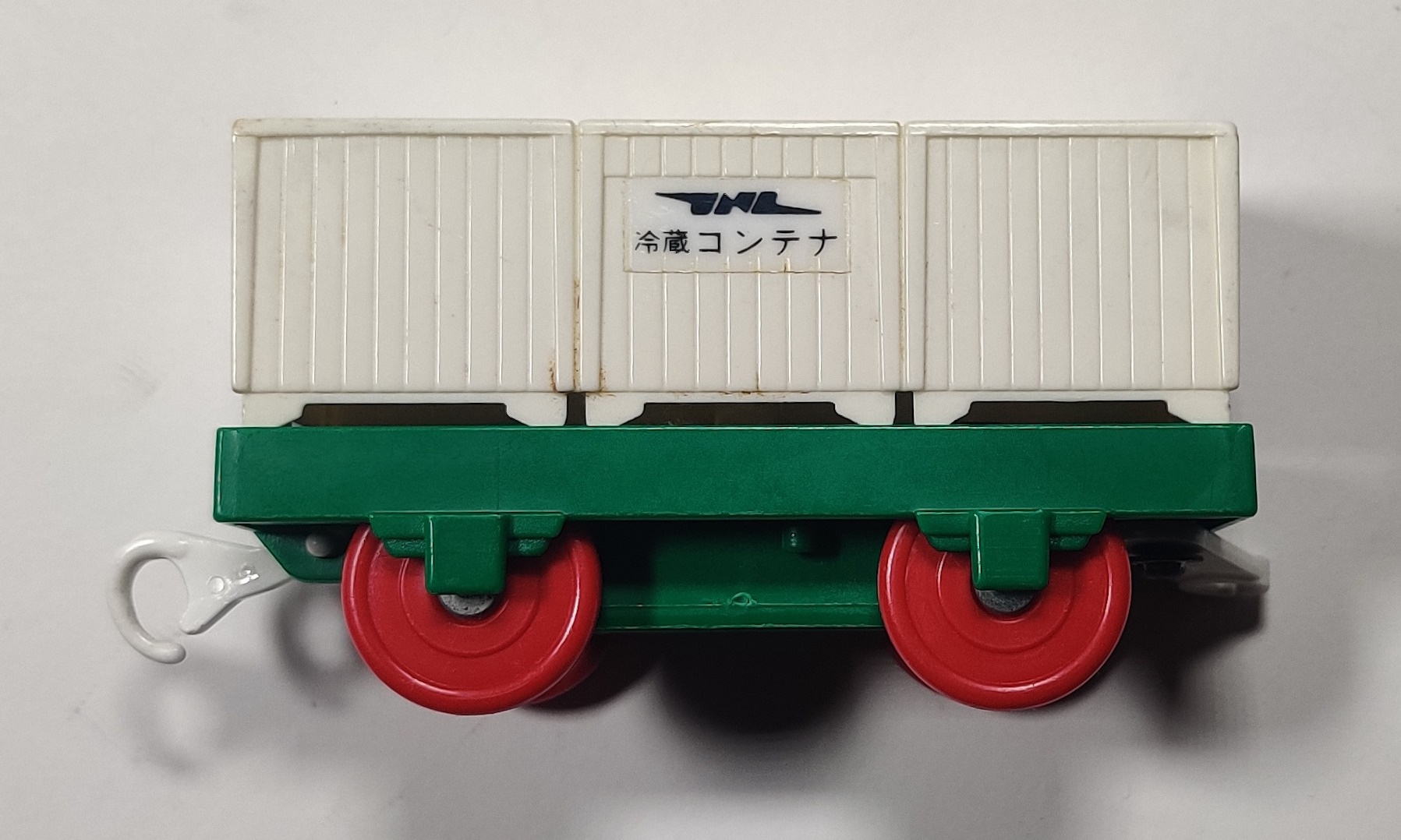
The refrigerator version of the container car uses the same molding in different colors and a new sticker. The sticker has the JNR logo and the text 冷蔵コンテナ for "refrigerated container." It was first shown on packaging, particularly for the three-car and set releases of the EF-58, around 1974 but does not seem to have actually appeared for sale until the individual release in 1976. Around 1993 this car began being included in the Fun Freight Wagons B pack.
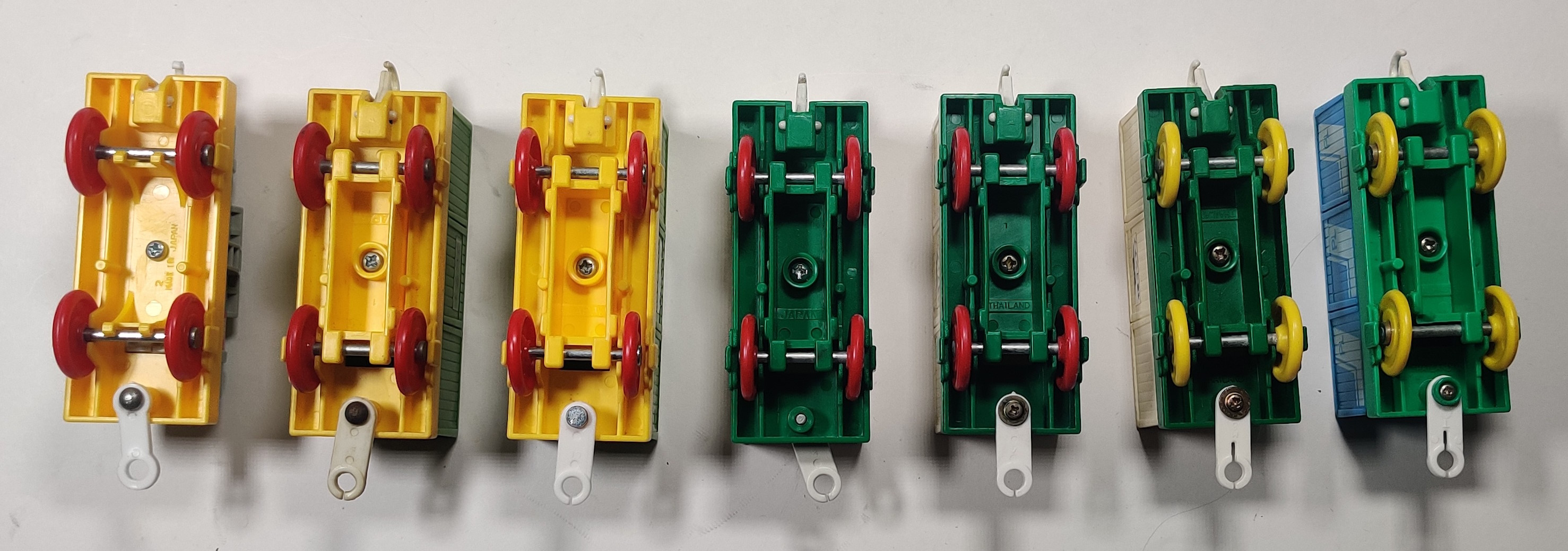
As I have many chassis revisions of the container cars, here is a look at the chassis changes over time (actually, the first two versions with plastic pegs are shown above, but I didn't have them at the time this photo was taken). The earliest releases do not have the hanging molded axle boxes and use the flat full-circle couplings held in with a plastic peg. The molding was updated with axle boxes by the mid 1970s, with the plastic pin replaced with a rounded metal one as shown on the far left. By 1980 the chassis had been updated to be more robust and the couplings were changed in the later 1970s to the almost-modern design, with the new axle holder insert being marked Japan. In the early 1980s the rounded pin holding the rear coupler in was changed to a flat design. I have a Japan-made flat pin container car with the pin and coupler inserted into the top of the chassis instead of the bottom, but it is possible this is a modification someone did later (I have seen a few of these cars missing their rear couplers, as I suspect the pins can either fall out or be pulled out by children over time, which would be less likely to happen if a parent flipped the pin and coupler to the top where is is sandwiched in by the rest of the car). When production shifted to Thailand the rear coupling was instead held on by a screw. Later in Thailand production the wheels of the refrigerator car were changed from red to yellow. The early 2000s container car that used the same mold used the updated plastic ring around the rear coupler.
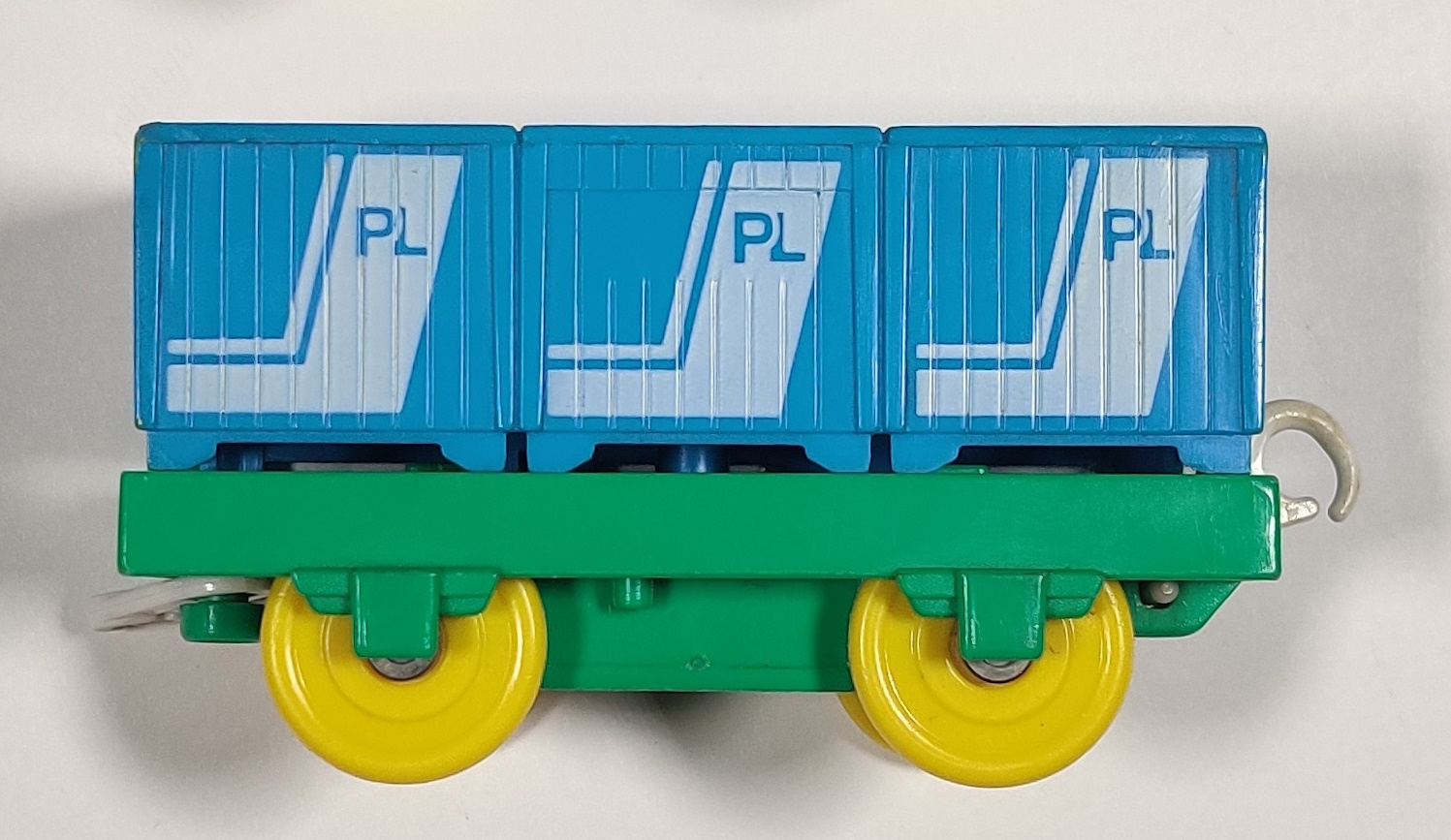
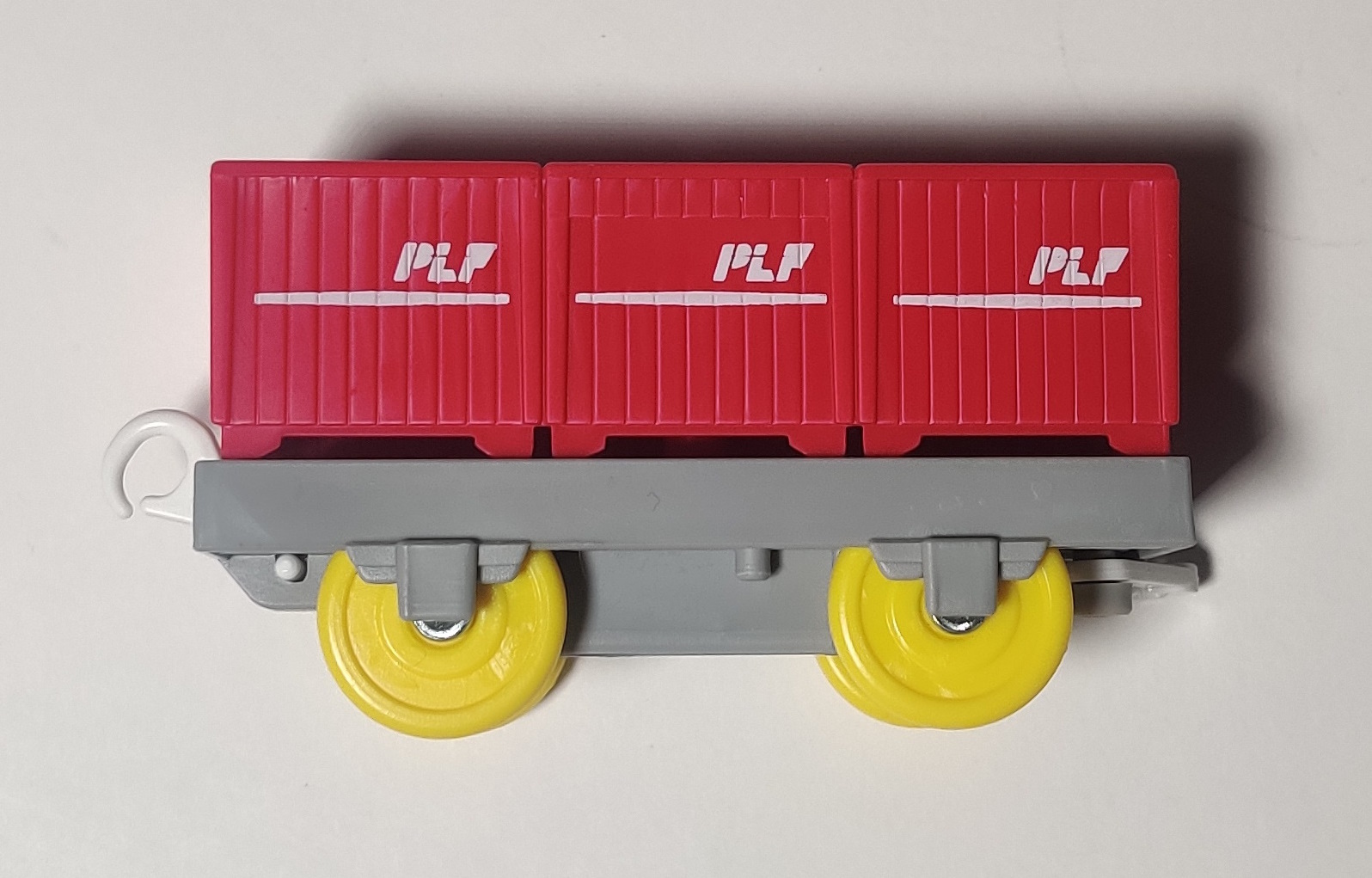
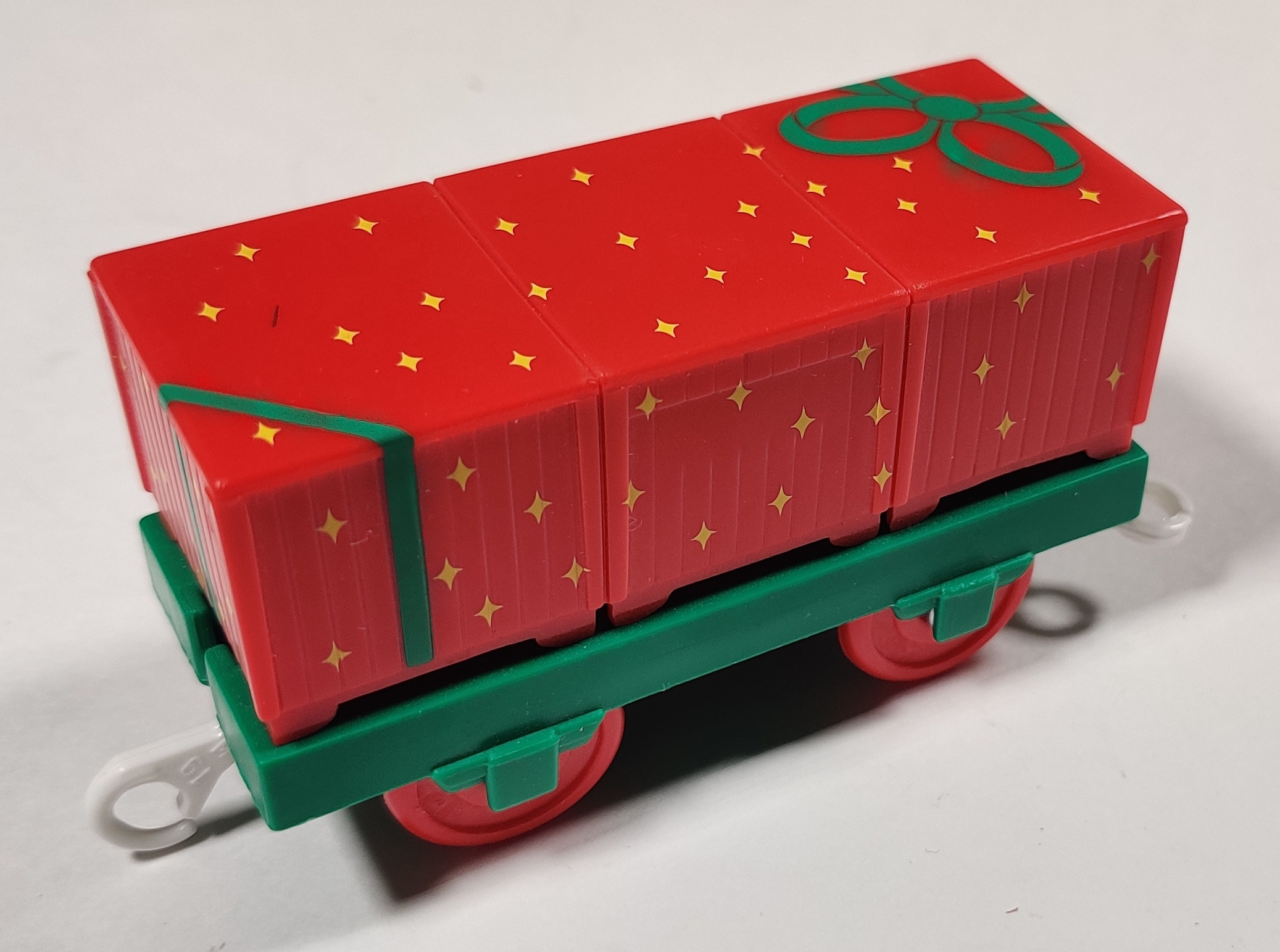
A few different set variants including a holiday present themed version for an export Thomas the Tank Engine set were produced.
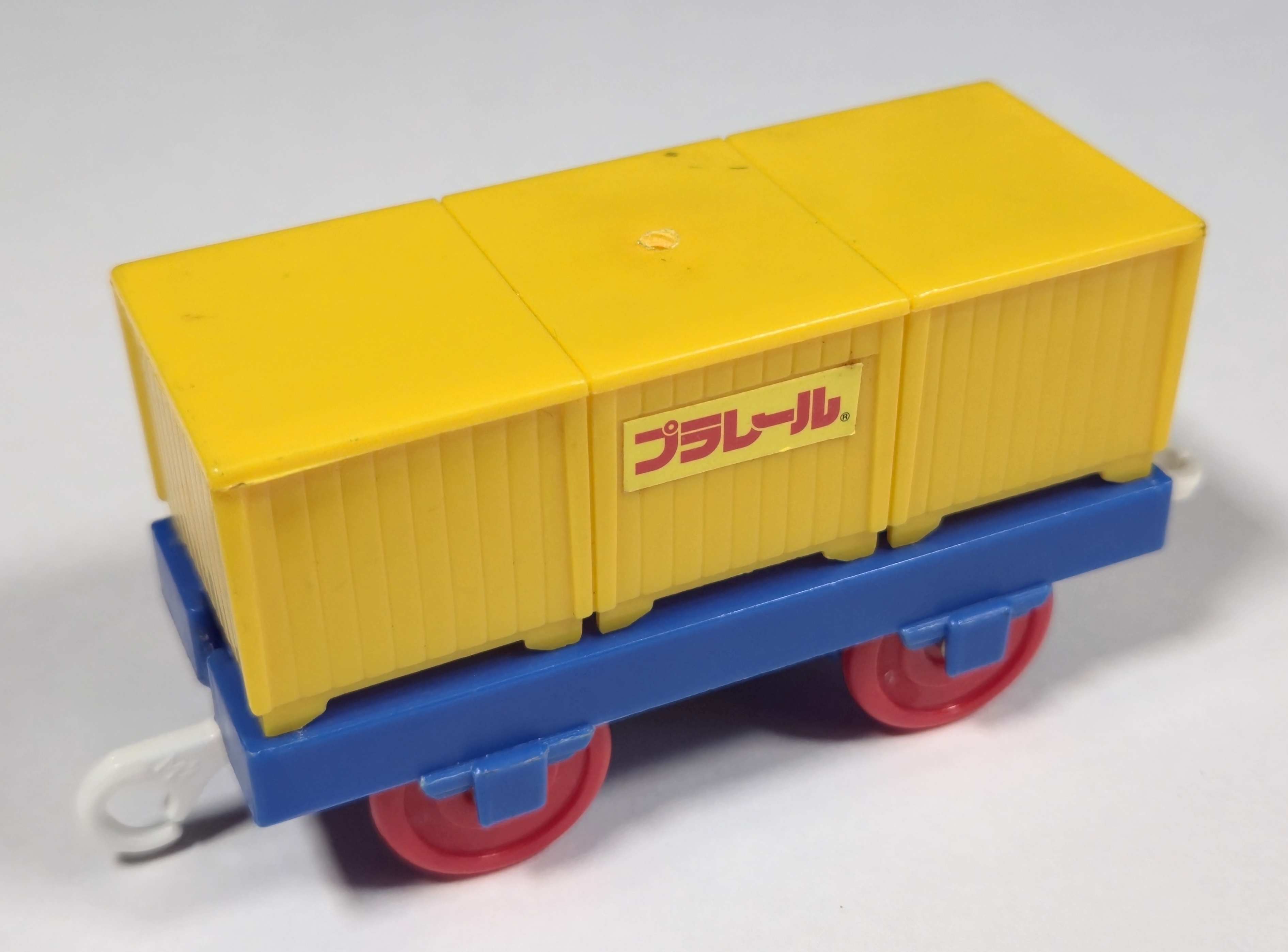
Tanker
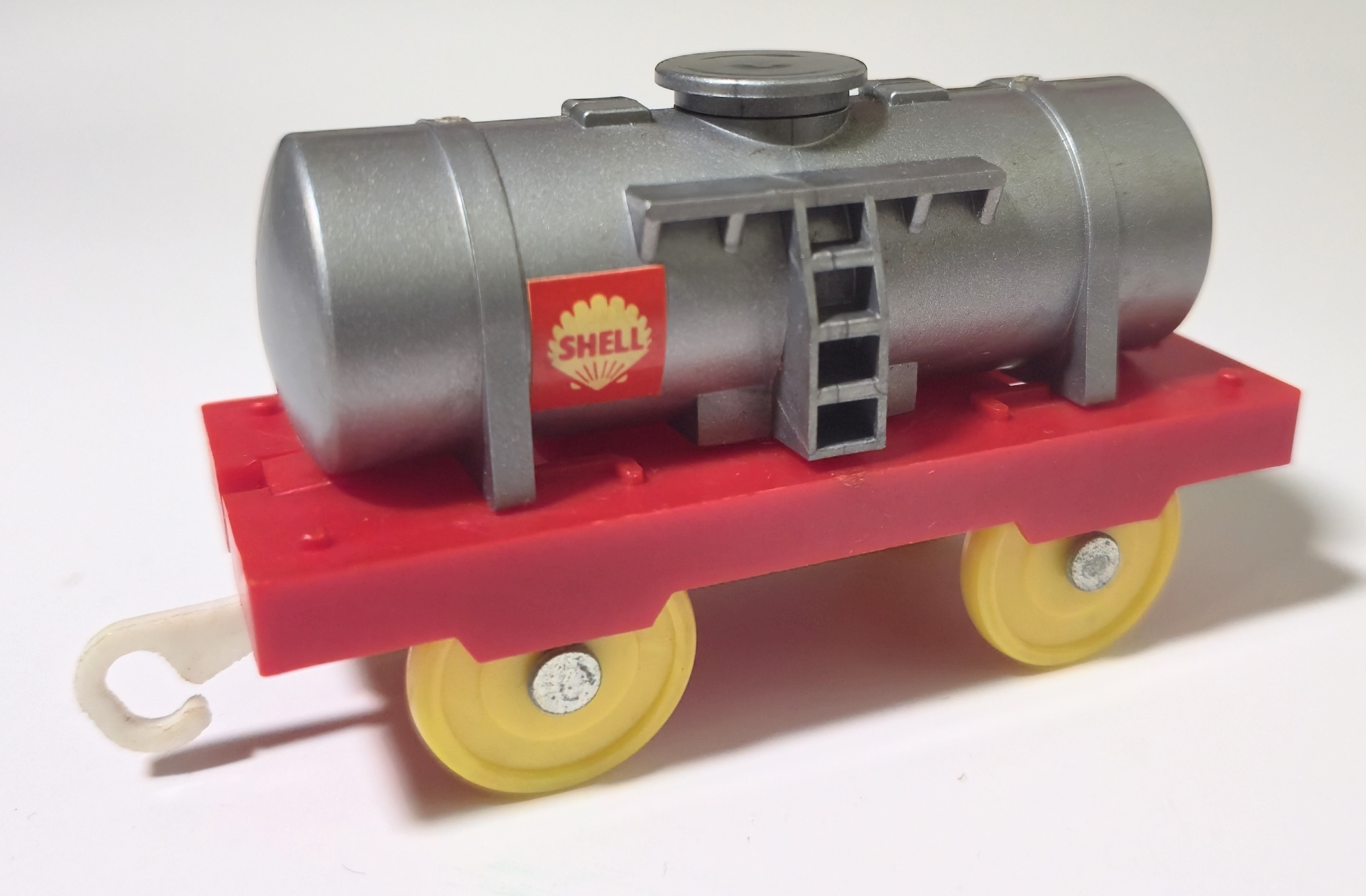
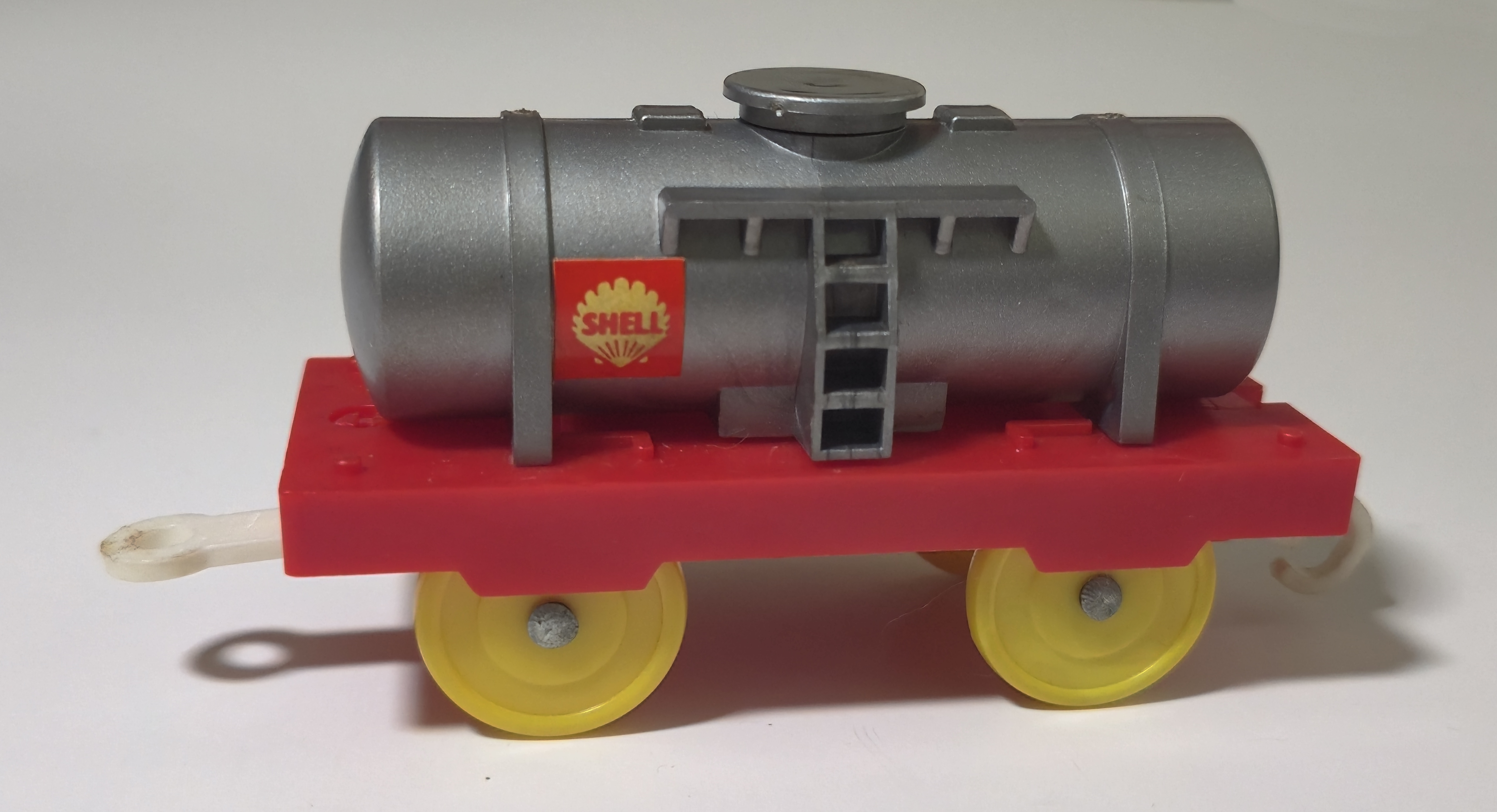
A tanker that uses the same chassis was also first released in 1970, appearing with the Electric Locomotive with red chassis and yellow wheels.

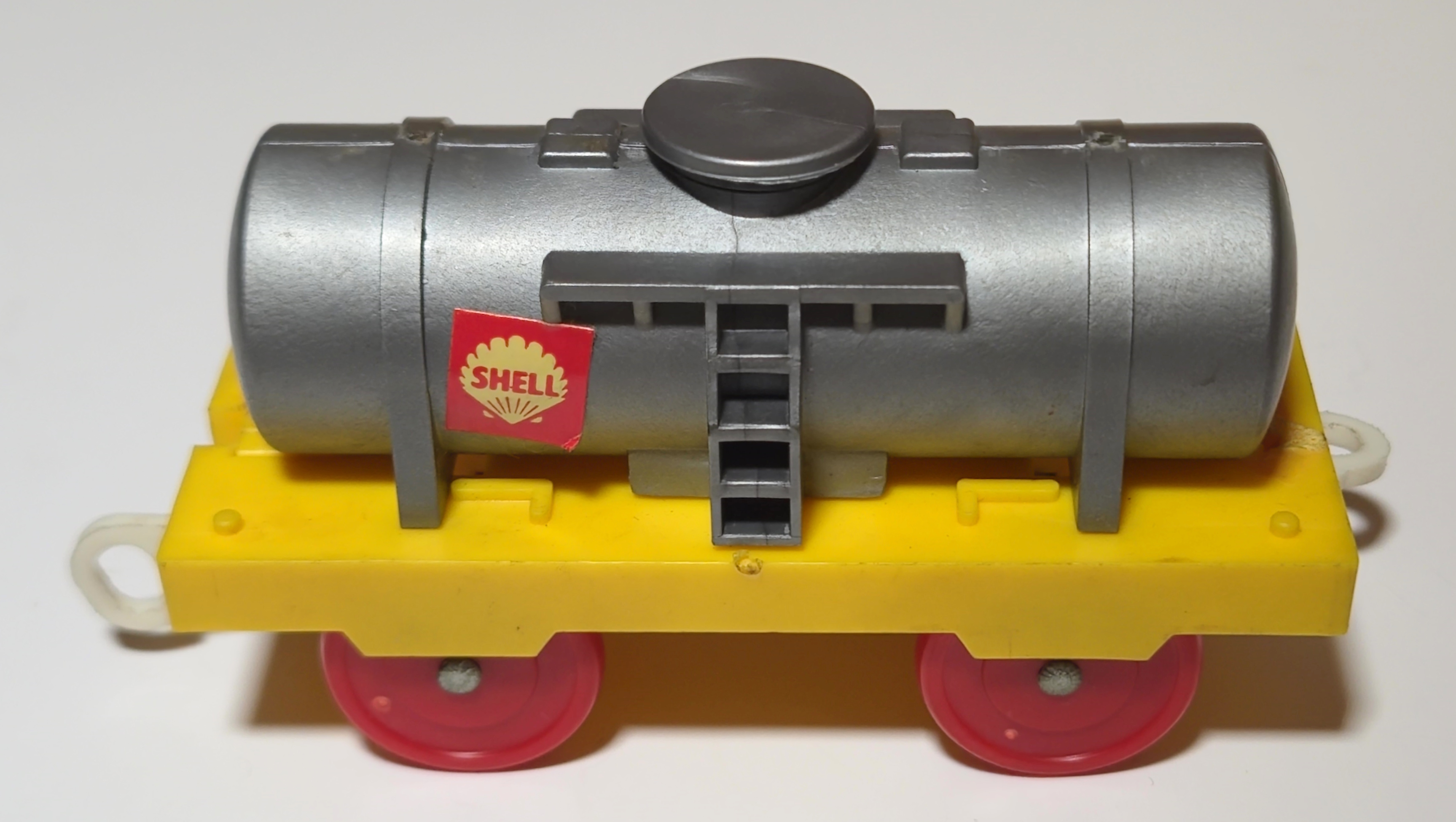
The earlier tankers have only the Shell logo on the sticker - this appeared on the original tooling version of the yellow-chassis tanker as well when it was changed in 1972, with mid 70s and on examples having a larger sticker with running information as well as changing the more silvery plastic mix for a plainer grey one at the time the chassis tooling was modified to have axleboxes covering the end of the axles.
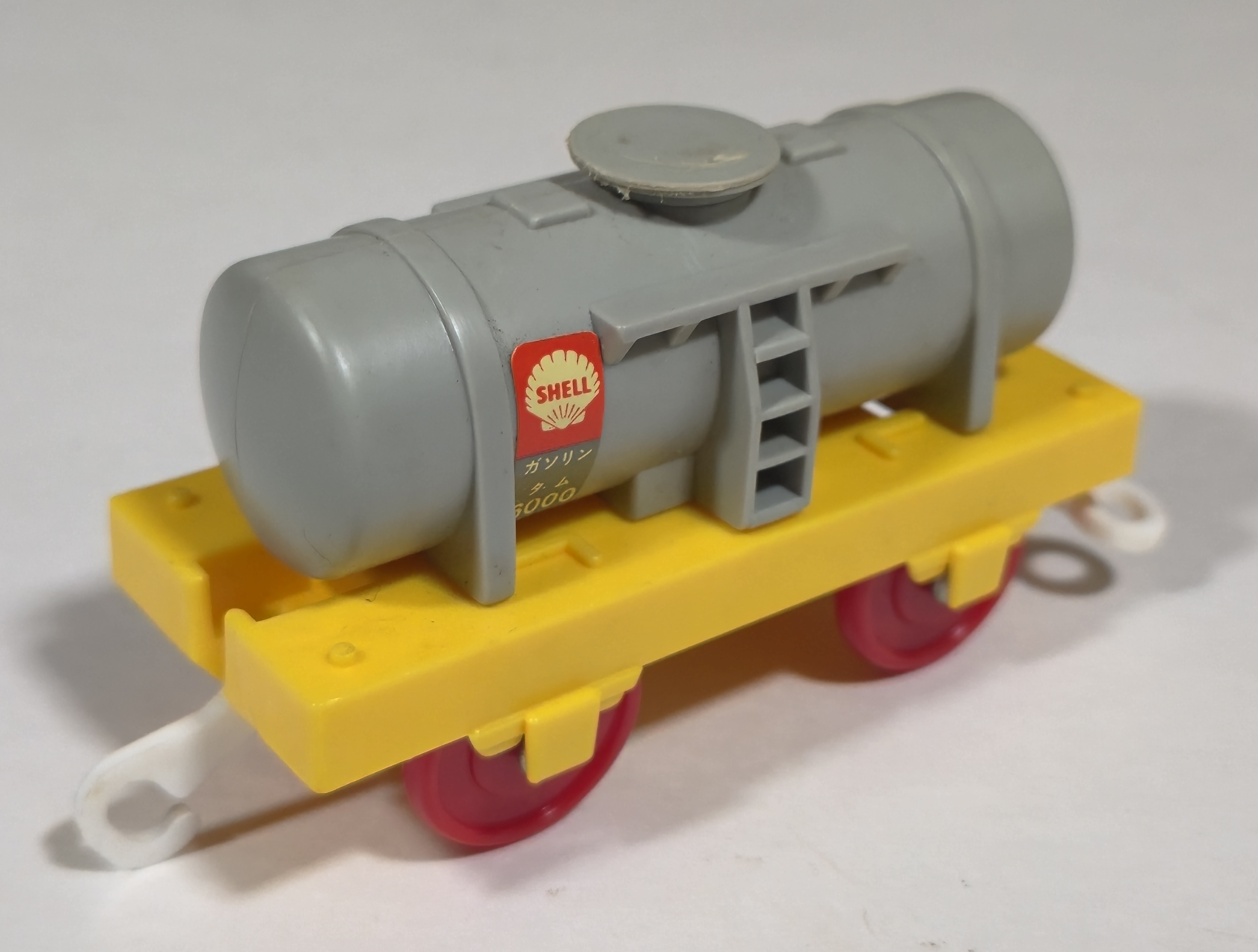
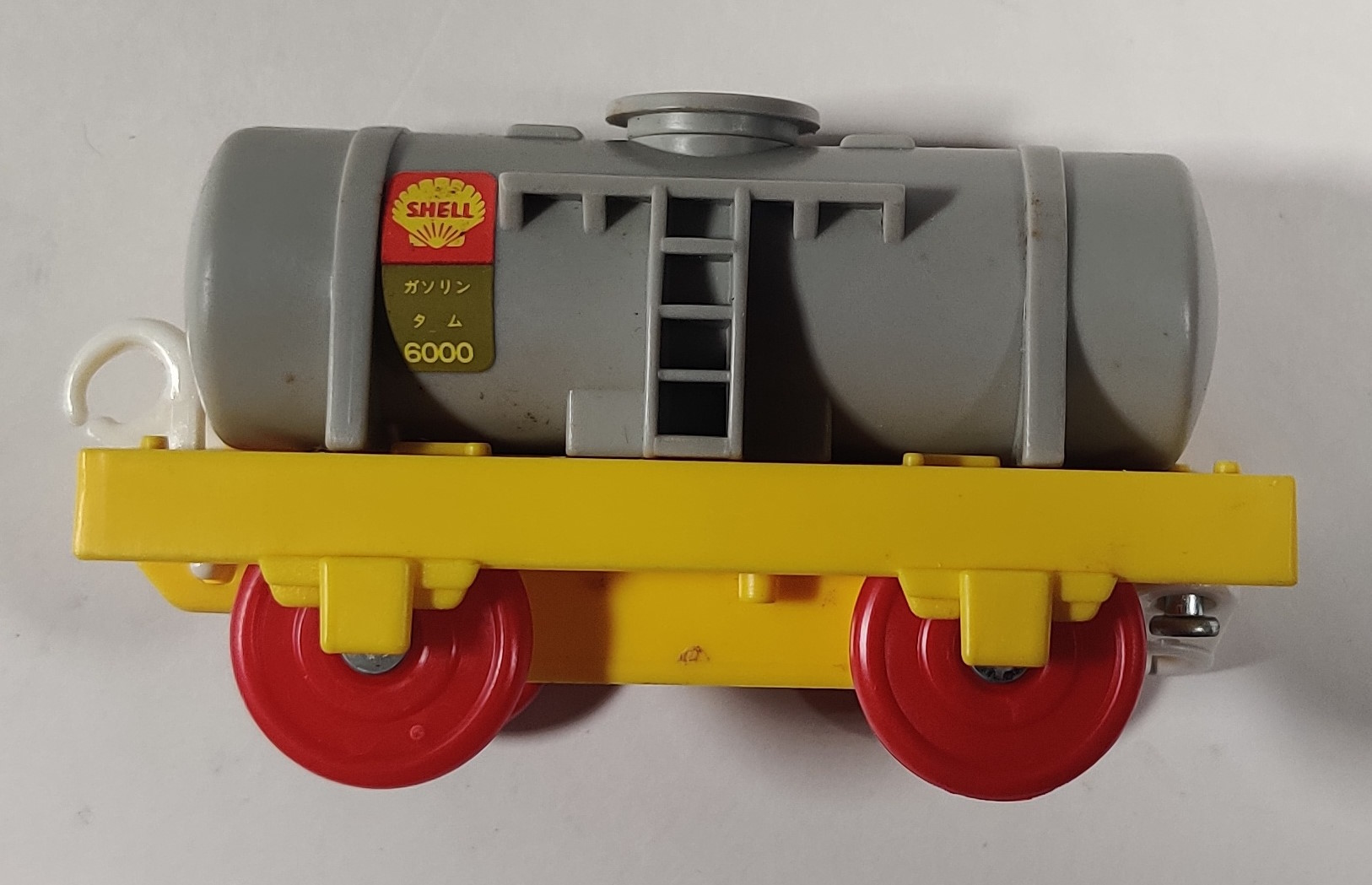
The most common tankers of this type are grey or yellow Shell tankers and the yellow version released with early Plarail Percys. This version was used in some versions of the EF15 3-car release as well as the 1980s D51 with Light and was even exported in the Chug-A-Log set.
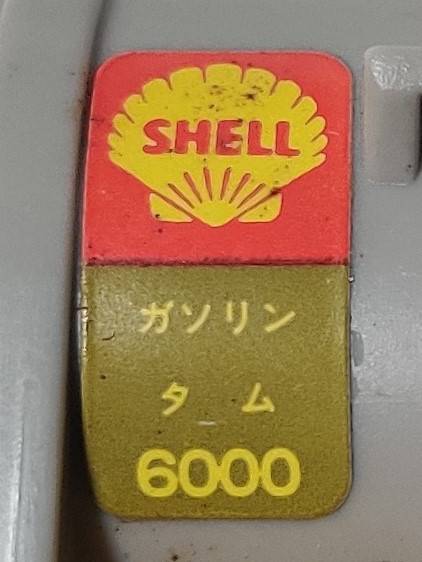
The Shell sticker also includes the text "ガソリン タム 6000" which translates to gasoline drum 6000, signifying that the tanker is meant to represent a type 6000 tank car, which I think it does a pretty good job at.
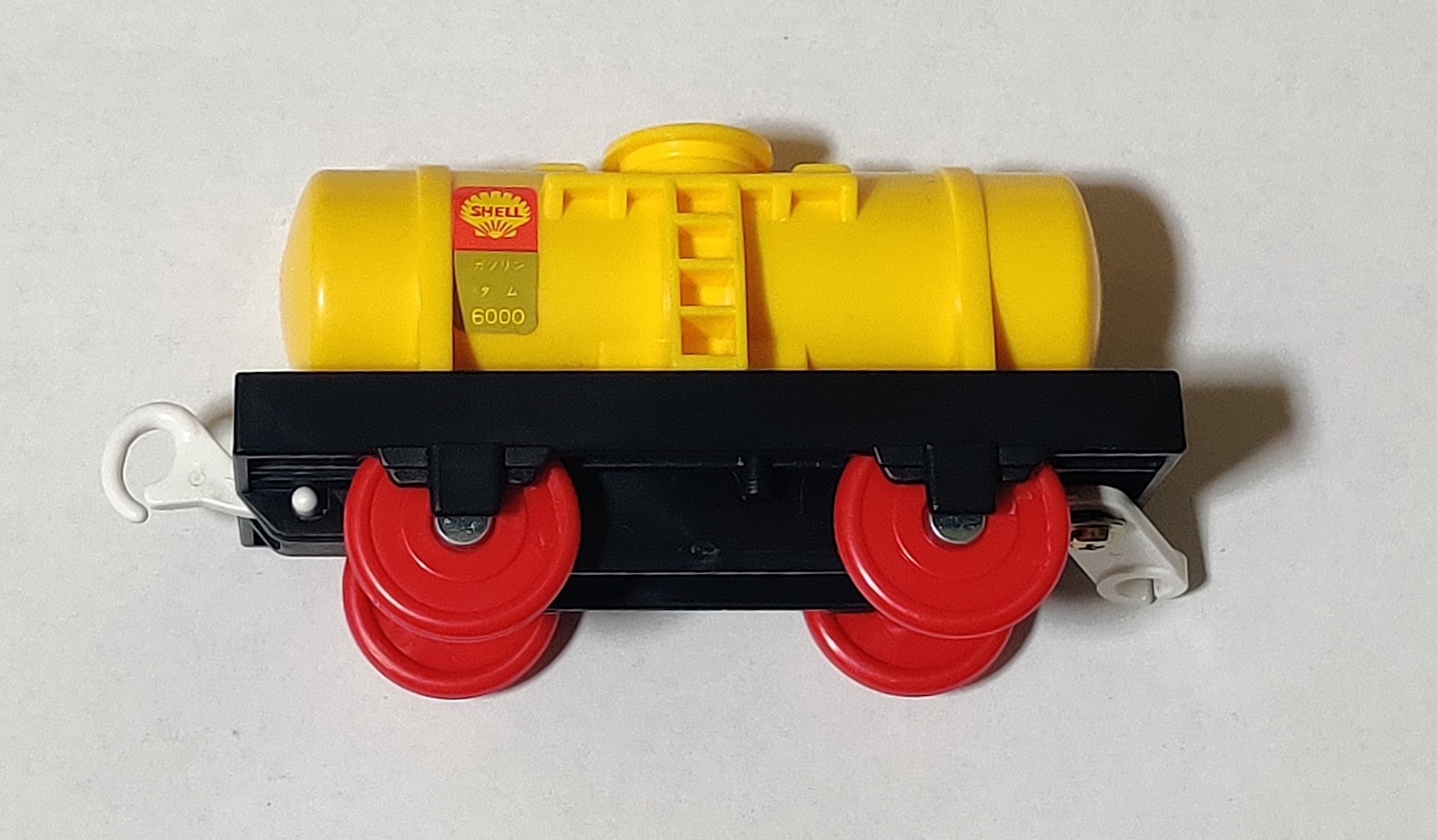

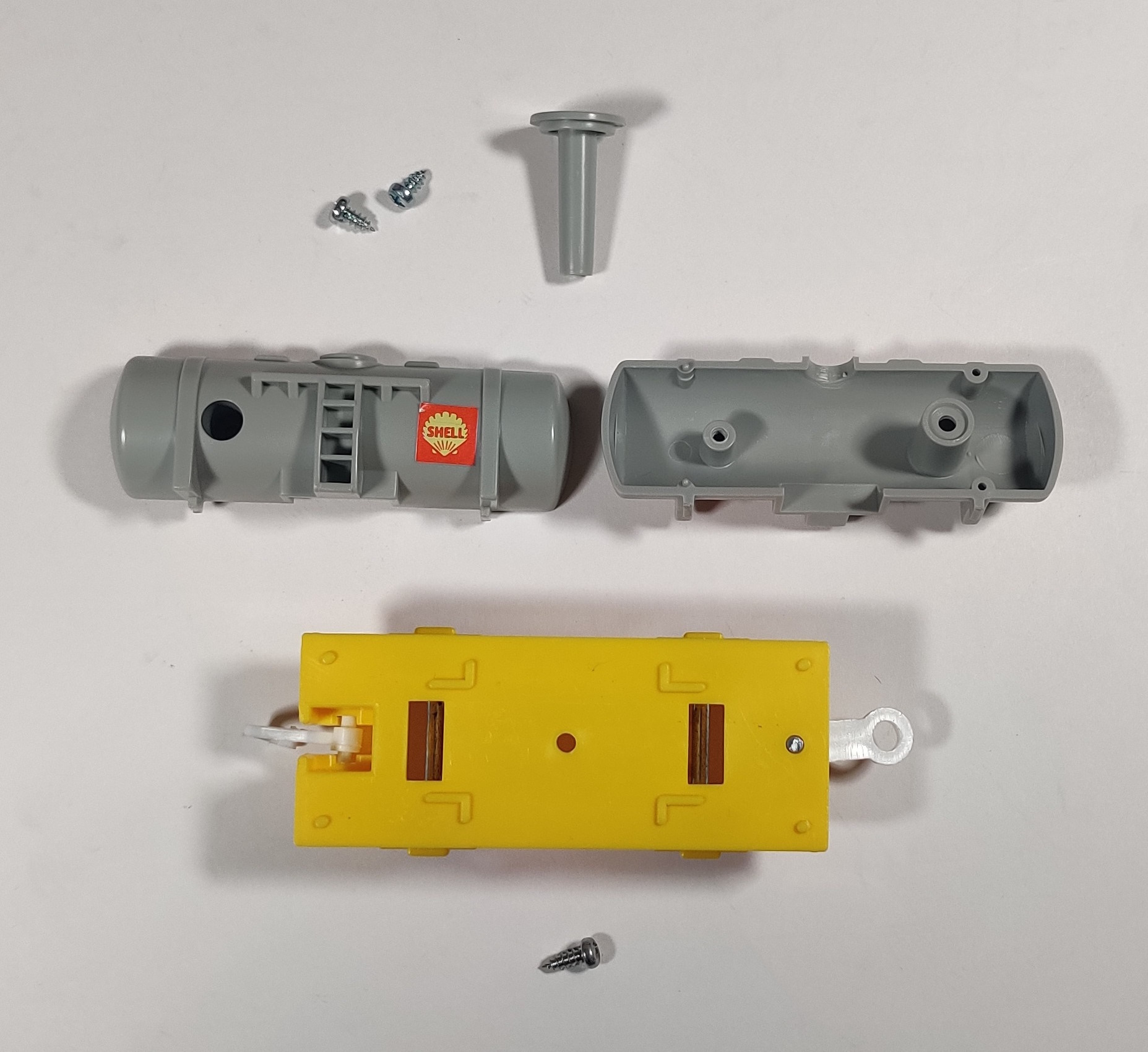
The tanker was produced in yellow in the late 1980s and 1990s D51 with Light releases with the updated stickers. The screw through the chassis affixes the filler cap of the tank car which sandwiches the sides of the tanker to the chassis. The stickers on the tank car usually cover up the screws that hold the two halves together but the circa 1975 export tanker from the Playrail Chug-A-Log does not have stickers covering its screws, making it easy to take apart without damaging the stickers. Being from the mid 70s, it still has the smaller central chassis screw hole - actually, it uses the older full-Shell-logo style sticker that I don't believe was otherwise used on the grey tankers with axleboxed tooling.
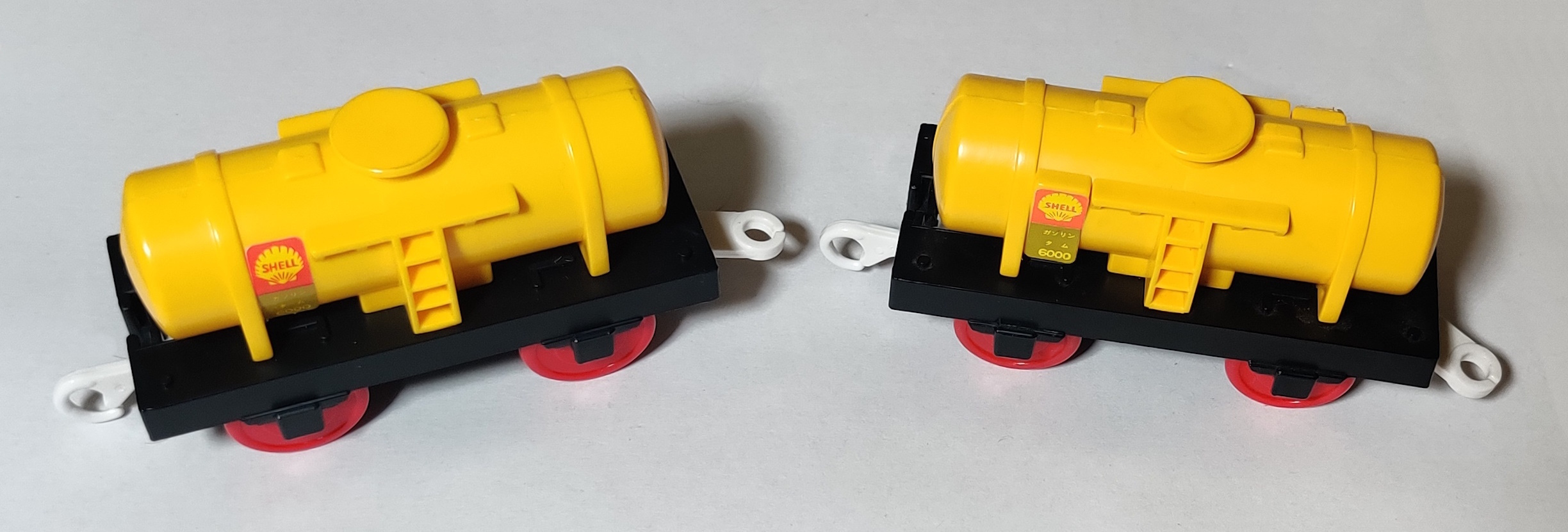
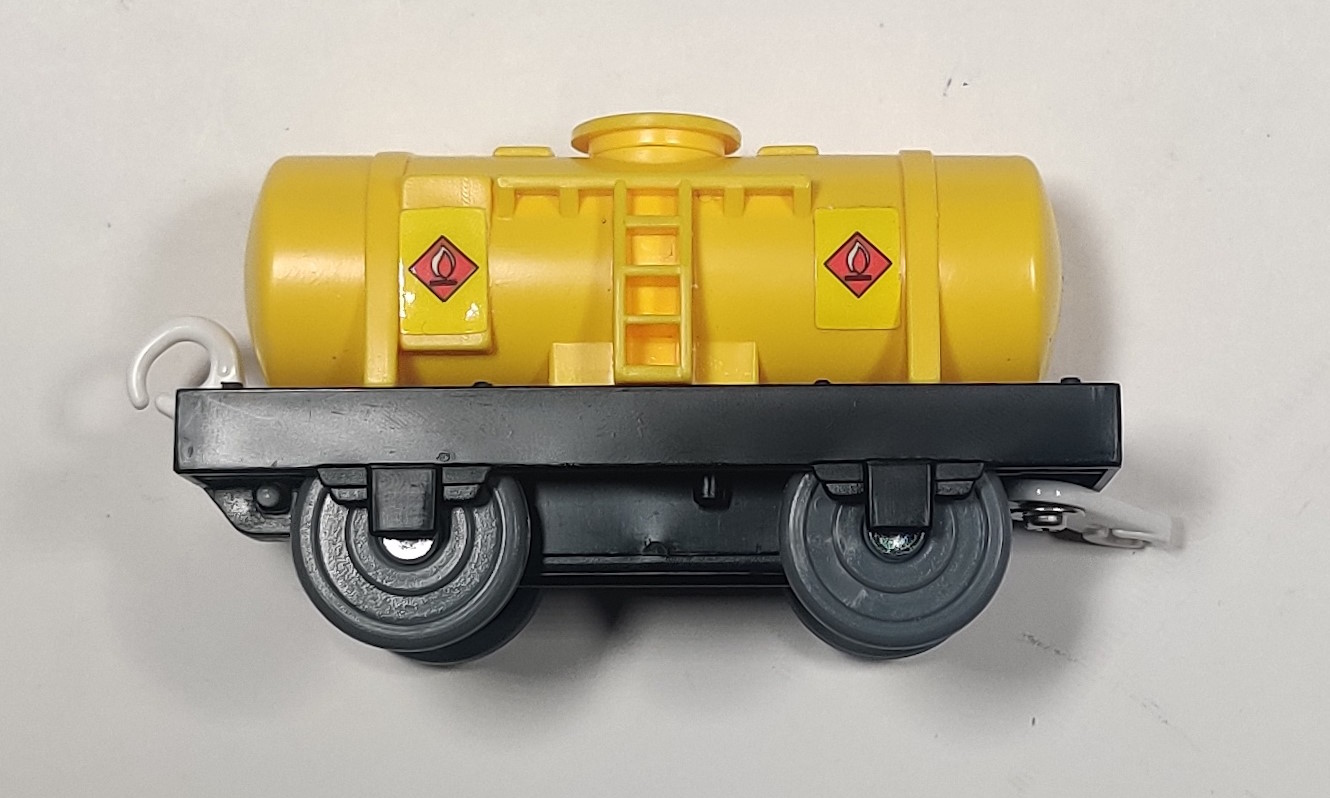
By 1994 the molding was updated to have a raised flat portion of the molding to put the sticker over instead of applying it directly to the rounded tanker body. This tooling was used for the Thomas version of the tanker which had two stickers on each side, meaning one was on the new raised section while the other was on the rounded tanker body like before.
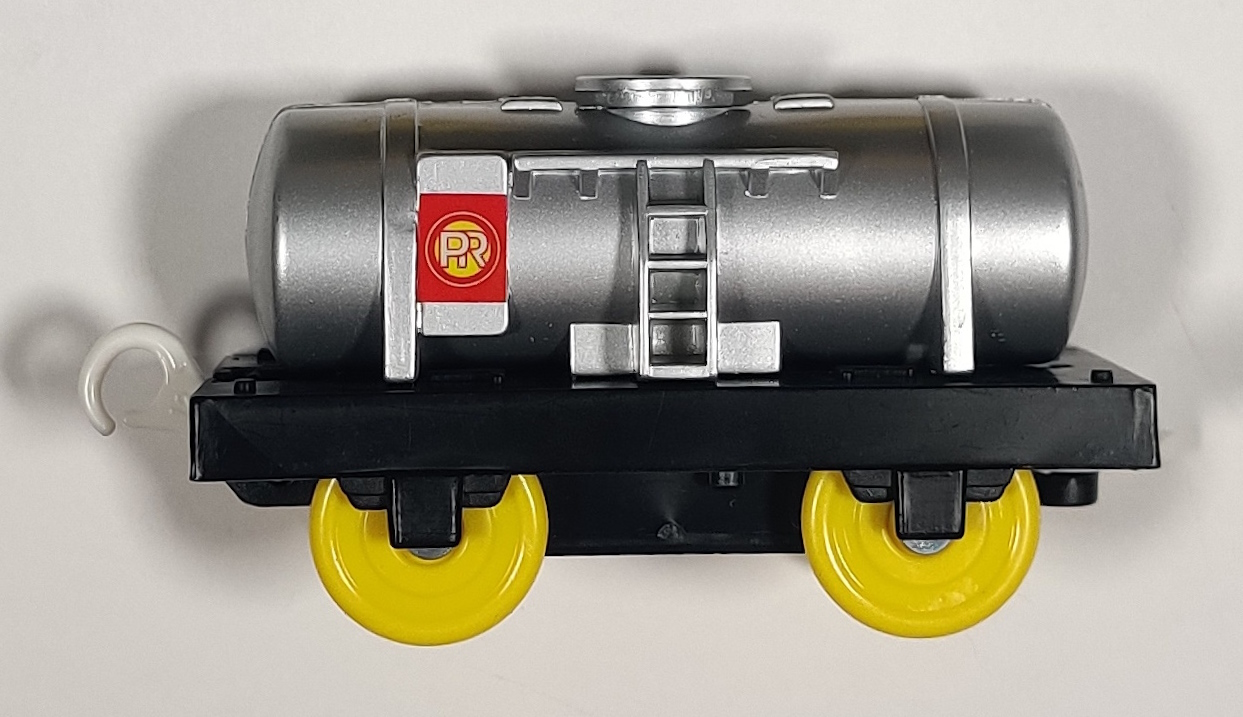

In 2001 the Railway Yard Full of Freight Cars Set included a silvery tanker with a PR logo sticker, likely for Plarail Railway or perhaps simply Pla-Rail. The round-side tankers even reappeared in yellow in the Thomas and Lots of Freight Cars Set in 2011, with no stickers applied.
Tank Car (Grey) (2001)


In 2001 a grey tanker with the same PR style sticker began being sold at Plarail Expo events as Tank Car (Grey). By the days of Takara Tomy, it had disappeared from sale. Like other Plarail, I suspect these were all made in one big batch and then sold until they were gone...
Car carrier

The car carrier is the least involved molding as it does not include a screwed-in upper component but rather a loose toy car. The chassis has a small plug inserted over the front coupling to keep it in place. The rear coupling on my car carrier is missing, while the front one is the more fragile early 70s design.

This example predates the more expanded axleboxes that appeared by the mid 1970s and has the more fragile chassis design.


My flatbed appears to have the name "Hiro" written on the side of it, perhaps the name of its original owner. This flatbed has the earlier chassis design with no axle boxes. The original cars were a single color of softish plastic. The car molding was also used in the オートファクトリー Auto Factory which was exported as the Child Guidance Mini-Car Factory.

Here it is pictured with the car from the 1989 Play Wagons Set. Like the other wagons, it did last long enough to be released in yellow from the updated axlebox tooling, usually with early C-12s.
Well Wagon
A well wagon was also released on the same chassis that was similar in style to the slightly later stubby log wagon. I do not currently own any of this type of wagon, although several can be seen in the Plarail Museum.